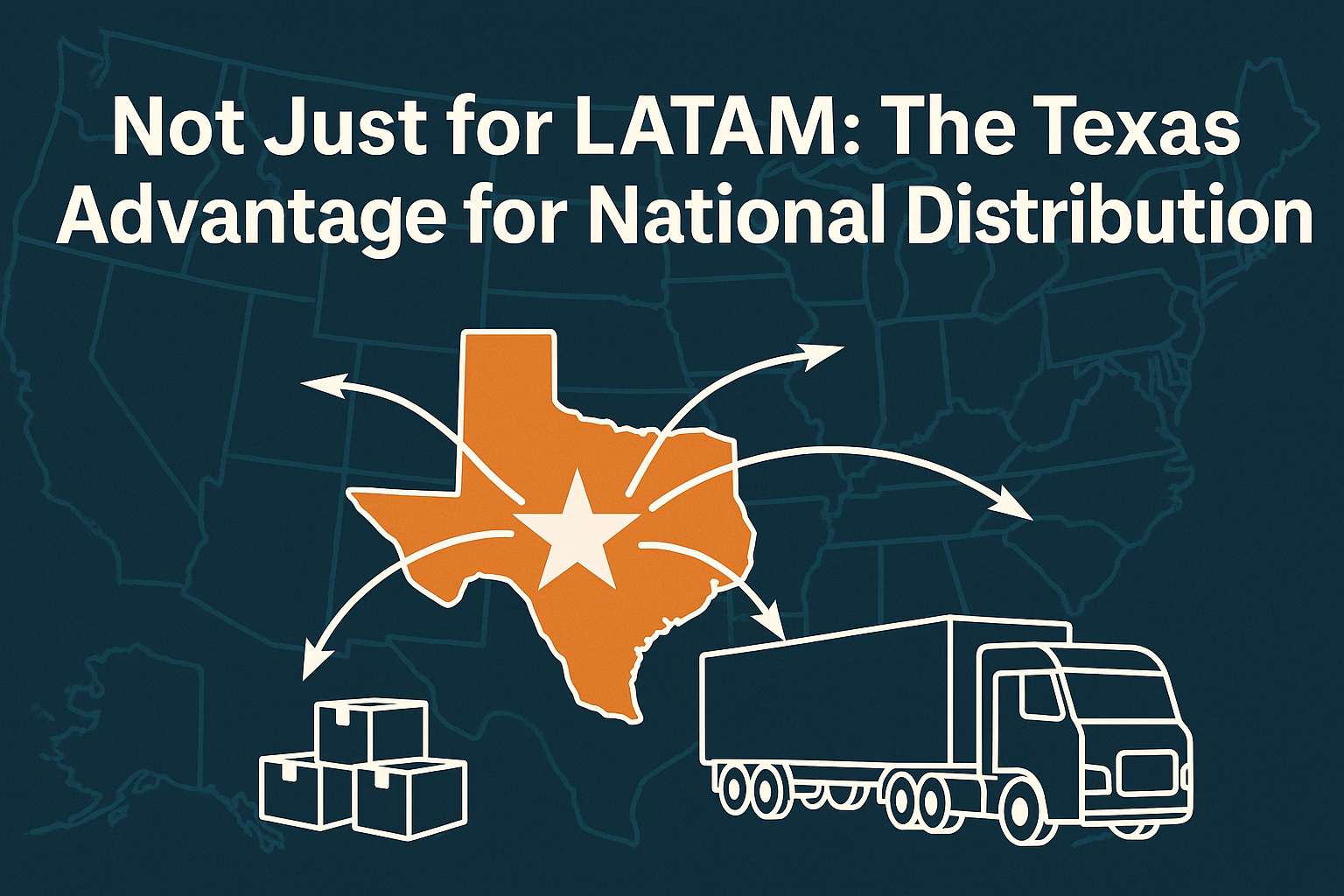When you hear “Texas logistics,” you might immediately think of a gateway to Latin America. While it’s true that the Lone Star State is an unrivaled bridge for cross-border commerce, this is only part of the story. For ambitious e-commerce brands, Texas is rapidly becoming the undisputed champion for nationwide distribution. Its central geographic location, robust infrastructure, and business-friendly climate create a unique competitive advantage that goes far beyond its southern border.
This article will dive deep into why a Texas-based fulfillment partner is your key to unlocking faster, more cost-effective shipping for your entire U.S. customer base. We’ll compare Texas to other major logistics hubs, analyze real-world scenarios, and provide actionable insights to help you make an informed decision for your supply chain.
The Geographic Advantage: The Heart of the U.S.
Think about a map of the United States. Where is the true center? It’s not on the coasts. It’s right in the middle, and Texas sits squarely within that strategic sweet spot. This central location is the single most important factor for achieving what’s known as “2-day ground shipping reach.”
What is 2-Day Ground Shipping Reach?
For most e-commerce businesses, offering fast shipping is non-negotiable. While expedited air freight is an option, it’s often prohibitively expensive. The holy grail is reaching as many customers as possible with affordable ground shipping within two business days. A fulfillment center’s location is the primary determinant of this reach.
From a central hub like Dallas-Fort Worth or Houston, your packages can reach major metropolitan areas across the Midwest, Southeast, and even parts of the West Coast and Northeast in just one to two days via standard ground carriers like FedEx Ground and UPS Ground. This dramatically reduces shipping costs compared to shipping from a single coastal warehouse.
For a detailed look at how this works, you can explore our Texas fulfillment and warehouse services page, which outlines our strategic locations and their impact on delivery times.
Texas vs. The Coasts: A Comparative Analysis
Let’s break down the benefits of a Texas location by comparing it to the two most common fulfillment models: the “bi-coastal” strategy and the single-hub approach.
Single-Coastal Warehouse (e.g., California or New York)
- Pros: Excellent for serving a high density of customers on that specific coast. Good for international inbound shipments from Asia (California) or Europe (New York).
- Cons: Extremely high shipping costs and long transit times for customers on the opposite side of the country. A California-based warehouse, for example, could take 5-7 business days to reach customers in Florida or the Northeast via ground shipping. This can lead to cart abandonment and a poor customer experience.
Bi-Coastal Strategy (e.g., California and New Jersey)
- Pros: Offers good 2-day ground reach for most of the U.S., effectively creating a “coastal power play” as we discussed in our recent blog post, Bi-Coastal Power Play: Combining California & New Jersey Warehouses for Max Speed.
- Cons: Requires managing inventory and operations across two distinct locations. This doubles your overhead, increases complexity, and can lead to costly stock-outs in one location while the other has an oversupply. For growing brands, this adds unnecessary operational friction and cost.
The Texas Advantage (Single Central Hub)
- Pros: A single, centrally located warehouse can achieve a similar 2-day ground reach as a bi-coastal setup, but with a fraction of the complexity and cost. You only need to manage one inventory stream, one set of operational procedures, and one relationship with your 3PL partner. This simplifies your supply chain and allows you to scale more efficiently.
- Cons: May have slightly longer transit times for the most extreme points of the country (e.g., northern Maine or western Washington). However, for the vast majority of the U.S. population, the delivery times are highly competitive.
—
Beyond Geography: The Economic and Operational Edge
Texas offers more than just a prime location. The state’s economic and logistical ecosystem is a powerful catalyst for e-commerce growth.
Robust Transportation Infrastructure
Texas has an extensive and well-maintained network of highways, railways, and major airports. The state is home to some of the nation’s busiest ports and air cargo facilities, including Dallas/Fort Worth International Airport (DFW), which is a major global hub. This infrastructure ensures that goods can move in and out of the state efficiently, a crucial factor for a successful fulfillment operation.
For more on how Texas logistics dominate the central U.S., check out our blog post, How a Dallas/Fort Worth 3PL Dominates Central U.S. Shipping.
Business-Friendly Climate
Texas is known for its favorable business environment, which translates to lower operational costs for your fulfillment partner, and in turn, for you. The lack of state income tax, competitive real estate prices, and a large, skilled labor pool contribute to a more cost-effective supply chain solution.
Case Study: A Mid-Sized D2C Brand’s Pivot to Texas
Consider the fictional brand “EcoEssentials,” a direct-to-consumer company selling sustainable home goods. They started with a single warehouse in Los Angeles. Initially, this worked well for their West Coast customer base. However, as they began to attract a national audience, they faced a growing problem: shipping to customers in states like Georgia, Ohio, and New York was taking 5-7 business days and costing a fortune. Their customer support team was overwhelmed with “where’s my order?” inquiries, and their reviews started to reflect dissatisfaction with long shipping times.
EcoEssentials decided to partner with a 3PL in Texas. By consolidating their inventory into a single central hub, they saw a dramatic transformation:
- Reduced Transit Times: The average transit time for their nationwide orders dropped from 4-5 days to a remarkable 2-3 days.
- Lower Shipping Costs: Their overall shipping expenses decreased by 15% due to the shorter average distance and use of more cost-effective ground services.
- Simplified Operations: They were able to focus on marketing and product development instead of managing inventory splits and coordinating between multiple warehouses.
- Improved Customer Satisfaction: Customer complaints about shipping times dropped by 60%, leading to higher repeat purchase rates and glowing reviews.
This case study is a prime example of how a strategic move to a Texas fulfillment partner can be a game-changer for a growing e-commerce brand’s bottom line and customer loyalty.
—
Key Features to Look for in a Texas Fulfillment Partner
Choosing the right 3PL is crucial. When evaluating potential partners in Texas, look for these key capabilities:
| Feature | Why it Matters |
|---|---|
| Advanced WMS (Warehouse Management System) | Provides real-time visibility into your inventory levels, order status, and shipping information. Look for a system that integrates seamlessly with all major e-commerce platforms like Shopify, Amazon, and WooCommerce. |
| Scalability & Flexibility | A great partner can handle your growth, whether you’re shipping 100 orders a month or 10,000. They should offer flexible storage options and be able to adapt to seasonal spikes. |
| Return Management Services | Efficient returns are critical for customer loyalty. A good 3PL will handle the entire reverse logistics process, from receiving and inspecting returns to restocking or disposing of them. (Learn more about our return management solutions). |
| Dedicated Support | You need a partner, not just a vendor. A responsive and knowledgeable support team is invaluable for resolving issues quickly and ensuring smooth operations. |
| Additional Value-Added Services | Look for partners that offer services like custom packaging, kitting and assembly, and FBA prep to streamline your supply chain even further. (Read our guide on the power of kitting & assembly). |
—
Frequently Asked Questions (FAQ)
Is a single Texas fulfillment center sufficient for nationwide shipping?
For most e-commerce businesses, especially those doing less than 500 orders a day, a single, centrally located fulfillment center in Texas is highly effective. It allows you to reach over 80% of the U.S. population with 2-3 day ground shipping, simplifying your operations and reducing costs compared to a multi-warehouse strategy.
How does Texas compare to other major logistics hubs like California or New Jersey?
Texas offers a unique blend of a strategic central location and a business-friendly environment. While California and New Jersey are excellent for serving their respective coasts, they often result in long transit times and higher costs for the rest of the country. A Texas hub provides a more balanced and cost-effective solution for true nationwide reach from a single location.
What types of businesses are best suited for a Texas-based fulfillment partner?
Businesses that have a widely dispersed U.S. customer base, sell products with high shipping costs due to size or weight, or are looking to simplify their supply chain are ideal candidates. This includes brands in the beauty, fashion, home goods, and electronics industries who need to offer fast, affordable shipping to compete with retail giants.
What is a 3PL and why should I consider using one in Texas?
A 3PL, or Third-Party Logistics provider, handles all aspects of your warehousing, order fulfillment, and shipping. By partnering with a 3PL in Texas, you can leverage their strategic location, infrastructure, and expertise to scale your business without the upfront investment in your own warehouse space, technology, and staff. It’s the fastest and most efficient way to achieve a professional-grade supply chain.
Conclusion: The Future of U.S. Fulfillment is Central
The traditional view of Texas as solely a hub for Latin American commerce is outdated. As e-commerce continues to evolve, the strategic advantages of a central location for nationwide distribution are becoming impossible to ignore. A single, well-chosen Texas-based fulfillment partner can replace the need for a complex and costly multi-warehouse strategy, providing a simpler, more efficient, and more profitable path to growth.
If you’re ready to unlock the full potential of your e-commerce business and simplify your supply chain, it’s time to look toward the heart of the country. A Texas-based fulfillment solution isn’t just a smart choice; it’s a strategic necessity for the future of your brand.

